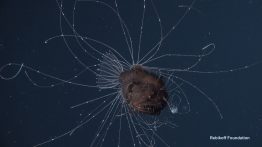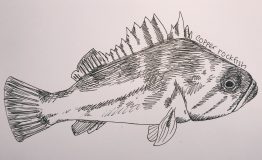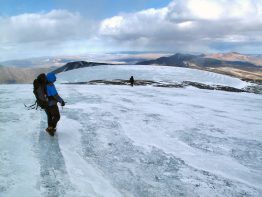Down deep off the south slope of São Jorge Island in the Azores, west of Portugal in the North Atlantic Ocean, a fearsome-looking fish and her parasitically attached mate drift almost helplessly, salvaging precious energy in their dark, food-scarce environment. The pair, a species never before seen alive by humans, was recorded recently on camera by researchers Kirsten and Joachim Jakobsen aboard the LULA1000, a submersible operated by the marine science-focused Rebikoff-Niggeler Foundation.
Read more at UW Today »The Seeley family follows its passion for science by giving to UW Environment
The Seeley family is building bridges between a pristine, remote atoll in French Polynesia and the University of Washington. James and Marsha Seeley, parents of UW alumni Laine, ’85, David, ’86, and Elizabeth, ’90, and grandparents to a growing number of Huskies, have led their family in supporting UW marine research at a field station on Tetiaroa. There, scientists and students from the College of the Environment can study delicate, healthy marine ecosystems and develop an understanding of conservation’s future in the face of climate change.
Read more in Columns Magazine »Marine and Environmental Affairs' student uses art to communicate science with #SundayFishSketch
If you log into Twitter on a Sunday and search for #SundayFishSketch, you’ll find a plethora of illustrations of fishes and other marine species. They’re submitted by scientists, artists and anyone else inspired to create, from Seattle to Scotland. #SundayFishSketch was created by Rene Martin, a Ph.D. student in the Department of Ecology and Evolutionary Biology at the University of Kansas, in 2016.
Read more »Glaciers in Mongolia's Gobi Desert actually shrank during the last ice age
The simple story says that during the last ice age, temperatures were colder and ice sheets expanded around the planet. That may hold true for most of Europe and North America, but new research from scientists in the Department of Earth and Space Sciences at the UW tells a different story in the high-altitude, desert climates of Mongolia. The recent paper in Quaternary Science Reviews is the first to date ancient glaciers in the high mountains of Mongolia’s Gobi Desert.
Read more at UW Today »Two species of ravens nevermore? New research finds evidence of ‘speciation reversal’
For over a century, speciation — where one species splits into two — has been a central focus of evolutionary research. But a new study almost 20 years in the making suggests “speciation reversal” — where two distinct lineages hybridize and eventually merge into one — can also be extremely important. The paper, appearing March 2 in Nature Communications, provides some of the strongest evidence yet of the phenomenon in two lineages of common ravens.
Read more at UW Today »





